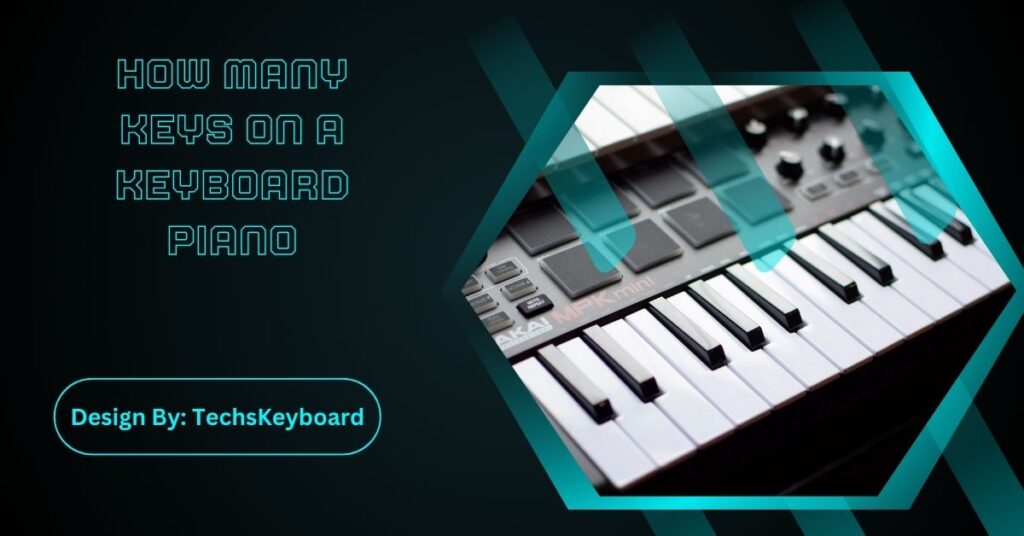Understanding the key count of a keyboard piano is essential for selecting the right instrument. Standard pianos have 88 keys, while variations exist for beginners, professionals, and electronic music producers.
In the world of music, the piano stands out as one of the most versatile and beloved instruments. Its rich tones and broad range make it a favorite among musicians of all genres. For those entering the world of piano playing, understanding the instrument’s layout is crucial, and this includes knowing the number of keys on a keyboard piano.
In this comprehensive guide, we’ll explore the history, types, and significance of key counts, providing essential knowledge for both beginners and seasoned players.
Introduction to the Keyboard Piano and Its Layout:
The keyboard piano, commonly referred to simply as a keyboard, is a versatile instrument used in various musical settings. From classical to pop music, its application is vast. The keyboard’s layout consists of a series of black and white keys, each corresponding to a different musical note. These keys are organized in a specific pattern that repeats across the instrument, creating octaves.
Understanding this layout is fundamental for learning to play the piano. The natural notes (A, B, C, D, E, F, and G) are represented by the white keys, and the flats and sharps are represented by the black keys. The arrangement is designed to be intuitive, allowing players to easily find and play chords and melodies.
Standard Key Count on a Keyboard Piano:

The standard number of keys on a keyboard piano is 88. This configuration includes 52 white keys and 36 black keys, covering a range of seven octaves plus a minor third. This setup has become the norm for most full-size pianos and some electronic keyboards, providing a wide range of notes that allow musicians to perform a vast repertoire.
The 88-key piano setup was established to cover a range sufficient for most musical compositions, giving pianists access to both the deep, resonant bass notes and the bright, high treble notes that characterize the piano’s sound.
How Many Keys on a Keyboard Piano?
While 88 keys are standard for full-size pianos, not all keyboard pianos adhere to this count. Here’s a breakdown of the most common configurations:
- 76 Keys: This slightly shorter keyboard is often found in digital pianos and synthesizers. It omits the highest and lowest octaves, making the instrument more compact without significantly compromising range.
- 61 Keys: Popular among beginners and for use in home settings, the 61-key keyboard covers five octaves. It’s sufficient for many pieces and is particularly favored by those who prioritize portability and space-saving.
- 49 Keys and 37 Keys: These are primarily used in MIDI controllers and some children’s keyboards. They offer basic functionality suitable for learning the fundamentals or producing digital music.
Also Read: Do I Turn on Continuous Rapid Trigger on Wooting Keyboard? – Here’s What You Need to Know!
A Brief History of the Keyboard Piano’s Key Count Evolution:
The evolution of the piano and its key count is a fascinating tale of innovation and adaptation. The earliest keyboard instruments, such as the clavichord and harpsichord, featured varying numbers of keys, typically fewer than modern pianos.
- 18th Century: The fortepiano, an early precursor to the modern piano, generally had around 60 keys. This was sufficient for the compositions of the time, which did not demand the extensive range we find in later works.
- 19th Century: With advancements in music composition and performance, the demand for a greater range led to the expansion of the keyboard. By the mid-1800s, the 88-key standard was established, thanks in part to composers pushing the boundaries of piano music.
- 20th Century and Beyond: While the 88-key piano became the standard, innovations in electronic keyboards introduced models with various key counts, catering to different needs and musical styles.
Types of Keyboard Pianos and Their Key Variations:

Modern keyboard pianos come in various forms, each with unique features and key counts designed for specific purposes:
Acoustic Pianos
- Grand Pianos: These are the largest and most resonant pianos, featuring the standard 88 keys. They are preferred for their rich sound and dynamic range, making them ideal for concert settings.
- Upright Pianos: More compact than grand pianos, uprights also typically have 88 keys. Their vertical design saves space, making them popular in homes and smaller venues.
Digital Pianos and Electronic Keyboards
- Digital Pianos: Designed to replicate the feel and sound of acoustic pianos, they often feature 88 keys. However, models with fewer keys are available for those needing a smaller footprint.
- Synthesizers and Workstations: Often equipped with 61 or 76 keys, these electronic instruments offer a wide range of sounds and features not found in traditional pianos.
- MIDI Controllers: These can have as few as 25 keys. They’re used to control software instruments in digital audio workstations (DAWs), offering flexibility in a studio setting.
How Many Keys On A Piano?
A standard piano typically features 88 keys, combining 52 white keys and 36 black keys. This full-sized range spans seven octaves plus a minor third, allowing pianists to explore a broad spectrum of musical expression. While most modern acoustic pianos adhere to this 88-key standard, smaller keyboards and digital pianos may offer 61, 76, or even fewer keys, catering to beginners or those with limited space. The 88-key format remains the professional benchmark.
Importance of Understanding Key Count for Beginners and Professionals
Whether you’re just starting your piano journey or are a seasoned professional, understanding the implications of key count is vital:
- For Beginners: Choosing the right keyboard can influence your learning experience. A keyboard with too few keys may limit your ability to play certain pieces, while a full-sized keyboard provides the complete range needed to explore any repertoire.
- For Professionals: Different performances and compositions may require specific ranges. Professionals often choose instruments based on the demands of their music, ensuring they have the necessary range and features.
- For Composers and Producers: Understanding key count helps in selecting the right tools for creating music. Whether composing classical music or producing electronic tracks, the right keyboard provides the flexibility needed for creativity.
FAQs:
1. Why do most pianos have 88 keys?
The 88-key standard provides the range needed for most music compositions, balancing deep bass and high treble notes, making it suitable for various genres and playing styles.
2. What’s the difference between 61 and 88-key keyboards?
A 61-key keyboard covers five octaves, sufficient for many beginner pieces, while an 88-key keyboard spans seven octaves plus a minor third, allowing for a complete musical range.
3. Are 76-key keyboards good for professionals?
Yes, 76-key keyboards are suitable for professionals who need portability and a wide range without the full size of 88 keys, although they lack some of the extreme high and low notes.
4. Why choose a MIDI controller with fewer keys?
MIDI controllers with fewer keys, such as 49 or 25, are ideal for music production and studio work where portability and controlling digital instruments in software are more important than range.
5. Do digital pianos always have 88 keys?
No, digital pianos come with various key counts. While many mimic the 88-key layout, models with 76 or 61 keys exist for those prioritizing space or specific music needs.
Conclusion:
Understanding keyboard key counts is crucial for choosing the right piano, whether you’re a beginner, professional, or producer. Standard 88-key pianos provide a comprehensive range suitable for most music. However, smaller options like 61 or 76-key keyboards cater to different needs, from compact practice to studio work. By selecting an appropriate key count, musicians and producers can enhance their practice, performance, and creativity with the right tool.


